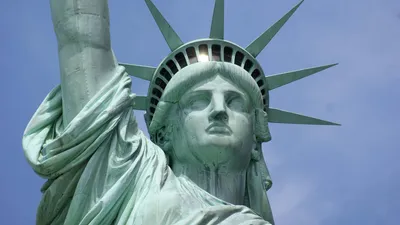ARTS & CULTURE

WHY THE STATUE OF LIBERTY IS AT THE CENTER OF AMERICA’S NEW CULTURE WAR
Why the Statue of Liberty Is at the Center of America’s New Culture War
How a powerful new painting has reignited debate over what Lady Liberty really stands for.
The Statue of Liberty is one of the most recognized symbols in the world—a towering figure of freedom, hope, and welcome. But beneath her torch and spiked crown lies a much deeper, often controversial meaning that continues to spark debate nearly 140 years after she was first unveiled.
Today, Lady Liberty finds herself in the middle of another national conversation—this time sparked by a bold new painting from renowned artist Amy Sherald.
A New Take on an Old Icon
Amy Sherald, best known for her official portrait of Michelle Obama, recently created a painting titled Trans Forming Liberty. It reimagines the Statue of Liberty as a Black transgender woman. Dressed in a flowing blue gown, pink hair ablaze, and holding a bouquet of Gerbera daisies instead of a torch, the figure is both powerful and tender.
Sherald says the work was meant to "hold space for someone whose humanity has been politicised and disregarded." In other words, her Lady Liberty was created to represent people who often feel left out of the American story.
A Painting Too "Controversial" for Washington?
The painting was supposed to appear in Sherald’s upcoming solo exhibition at the Smithsonian’s National Portrait Gallery in Washington, DC. But after behind-the-scenes concerns that the piece might upset President Donald Trump—who recently signed an executive order recognizing only two genders—organizers suggested removing it.
Rather than censor her work, Sherald pulled out of the exhibition altogether, calling the decision a stand against “a culture of censorship.”
The painting is now on display at the Whitney Museum in New York as part of her touring show American Sublime—and it's attracting even more attention because of the controversy.
A Long History of Debate
This isn’t the first time the Statue of Liberty has been caught in political crossfire. When it was first unveiled in 1886, suffragettes criticized it as hypocritical—how could a statue of a woman represent liberty when women couldn’t even vote? Meanwhile, anti-immigrant voices pushed back against the message of welcome that the statue (and its famous poem by Emma Lazarus) sent to newcomers.
Now, with Sherald’s version sparking conversations about gender, race, and who gets to be represented, Lady Liberty once again finds herself at the heart of America's culture wars.
Politics, Art, and the Fight for the American Story
President Trump’s administration has been increasingly vocal about reshaping the way American history is told in public spaces. A recent executive order titled “Restoring Truth and Sanity to American History” limits federal support for exhibitions or museums that are seen as "divisive" or “inconsistent with Federal law and policy.”
This move has led to pressure on public institutions to avoid narratives that touch on racism, slavery, or social inequality—even if those stories are part of the nation’s history. Sherald’s painting, and others like it, are now on the front lines of this debate.
Can Liberty Bend Without Breaking?
Interestingly, the physical structure of the Statue of Liberty was built to bend, not break. Gustave Eiffel, who engineered the inner frame (yes, the same man who built the Eiffel Tower), designed it so that the statue’s thin copper skin could flex in strong winds.
Maybe that’s a metaphor worth holding onto. The meaning of liberty has always shifted over time. It's been debated, reshaped, and redefined by each generation. But like the statue herself, perhaps true liberty is flexible enough to survive—even when the winds of controversy blow hard.
"This represents a significant development in our ongoing coverage of current events."— Editorial Board









